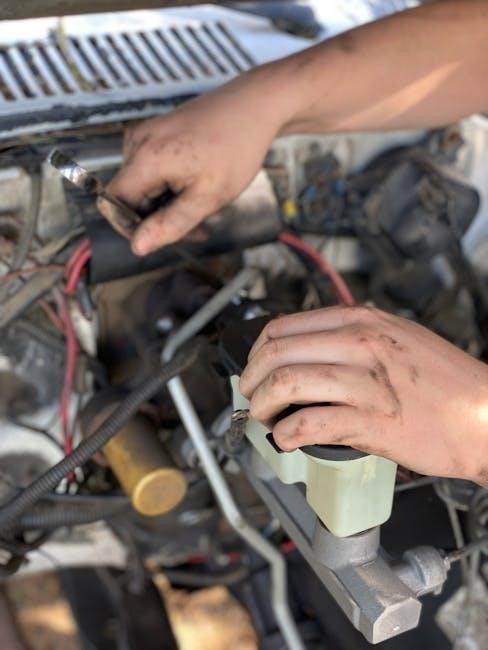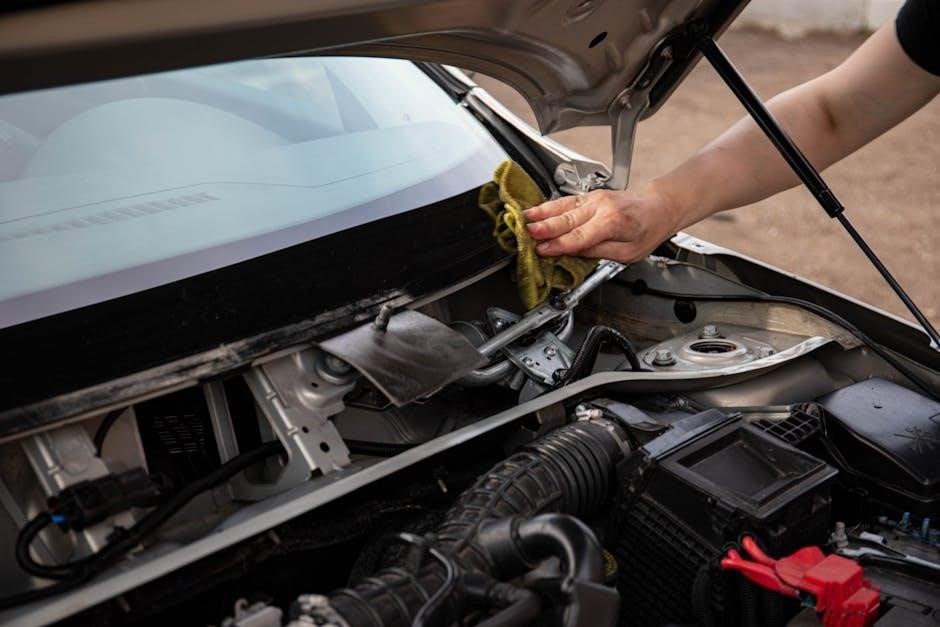The LS motor, known for its powerful performance and versatility, pairs exceptionally well with manual transmissions, offering drivers enhanced control and a more engaging driving experience. The T-56 6-speed and T56 Magnum are popular choices, delivering precise shifts and robust strength for LS swaps, making them ideal for both street and track applications.
1.1 Overview of LS Engines
The LS engine family, introduced by General Motors in 1997, is renowned for its lightweight aluminum block design, impressive power output, and efficiency. Known for their versatility, LS engines have been used in various GM vehicles, from high-performance Corvettes to trucks and SUVs. Their compact size and robust construction make them a popular choice for engine swaps. The LS series includes generations like Gen III and Gen IV, offering advancements such as variable valve timing and improved fuel systems. These engines are celebrated for their durability, ease of modification, and abundant aftermarket support, making them a favorite among enthusiasts for both stock and high-performance applications.
1.2 Benefits of Manual Transmissions for LS Swaps
Manual transmissions offer distinct advantages for LS engine swaps, including enhanced driver control, improved fuel efficiency, and a more engaging driving experience. They typically weigh less than automatics, reducing overall vehicle mass. The T-56 and T56 Magnum are popular choices, providing strong, precise shifts and excellent durability. Manual transmissions also allow for better gear ratio customization, optimizing performance for specific applications. Additionally, they are often more cost-effective and reliable in high-performance scenarios. However, compatibility and fitment require careful consideration, as LS engines may need specific adapter plates or bellhousings to mate with manual transmissions, ensuring proper alignment and functionality.

Popular Manual Transmissions for LS Swaps
The T-56 6-speed and T56 Magnum are highly sought-after for LS swaps, offering exceptional strength, precise shifting, and compatibility with a wide range of applications.
2.1 Tremec T-56 6-Speed Manual Transmission
The Tremec T-56 6-speed manual transmission is a top choice for LS swaps due to its strength, reliability, and smooth shifting. It bolts directly to LS engines, requiring minimal modifications to the transmission tunnel. Known for its durability, the T-56 is ideal for high-performance applications, offering a wide range of gear ratios to suit both street and track driving. Its compatibility with GM vehicles and extensive aftermarket support make it a favorite among enthusiasts. Whether you’re building a resto-mod or a race car, the T-56 delivers unmatched performance and driver engagement.
2.2 T56 Magnum: The Ultimate Choice for LS Swaps
The T56 Magnum is considered the pinnacle of manual transmissions for LS swaps, offering unparalleled strength and reliability. Designed for high-performance applications, it features a robust construction and precise shifting characteristics, making it ideal for high-torque LS engines. With a wide range of gear ratios, the Magnum excels in both street and track environments. Its durability and smooth operation have made it a favorite among enthusiasts. The T56 Magnum is often paired with LS engines for its ability to handle aggressive driving while maintaining driver engagement. Its popularity in the aftermarket ensures extensive support and availability of performance upgrades.
2.3 NV3500: A Budget-Friendly Option
The NV3500 is an economical choice for LS swaps, offering affordability without compromising performance. Derived from early 2000s Blazers, it’s easily sourced from junkyards, often for a few hundred dollars. Enthusiasts praise its simplicity, requiring only a basic cleanup and fluid change for installation. Ideal for budget-conscious builders, the NV3500 provides reliable service for everyday driving and mild performance. While it may lack advanced features, its accessibility and ease of maintenance make it a practical option for those seeking a cost-effective manual transmission solution for their LS engine projects.
2.4 AR5 Transmission: Compatibility and Performance
The AR5 transmission, sourced from Chevrolet Colorado, is a 5-speed manual option for LS swaps. While it requires specific adapters like the Fabbot kit for compatibility, it offers a cost-effective solution. The AR5 is not a direct bolt-on, necessitating modifications for proper fitment. With a lower torque capacity compared to the T-56, it is best suited for lighter vehicles and everyday driving. Its simplicity and affordability make it a practical choice for budget-conscious builders, though it may not meet the demands of high-performance applications. The AR5 strikes a balance between accessibility and functionality for LS engine projects focused on reliability and moderate power output.
2.5 TKX 5-Speed Manual Transmission
The TKX 5-speed manual transmission is a modern, compact option for LS engine swaps, offering excellent performance and reliability. Designed with a robust internal structure, it features optimized gear ratios for LS applications, making it ideal for both street driving and light track use. The TKX is part of a universal swap kit, ensuring compatibility with various LS engines and simplifying installation. Its lightweight design and improved shift quality enhance driving dynamics. While not as high-torque-capable as the T-56, the TKX provides a cost-effective solution for builders seeking a balance between performance and affordability, making it a versatile choice for LS-powered vehicles.
2.6 AX15 and SM465: Other Manual Transmission Options
The AX15 and SM465 are alternative manual transmission choices for LS engine swaps, offering unique benefits. The AX15 is a compact, lightweight 5-speed with an overdrive gear, making it ideal for street-driven vehicles and light-duty applications. It’s known for its strength and durability, fitting well with LS engines when paired with the right adapter kit. The SM465, a heavy-duty 4-speed, is better suited for off-road use or heavy hauling due to its low “granny” gear. Both transmissions provide strong aftermarket support and are viable options for builders seeking reliable, manual shifting in their LS-powered projects without the need for more complex 6-speed setups.

Transmission Compatibility and Fitment
Ensuring proper transmission compatibility and fitment is crucial for LS swaps. Adapter plates, bellhousings, and flywheel alignment are key to achieving a seamless engine-transmission connection and optimal performance.
3.1 Adapter Plates and Bellhousings for LS Swaps
Adapter plates and bellhousings are essential for connecting LS engines to manual transmissions, ensuring proper alignment and compatibility. These components bridge the engine and transmission, enabling a seamless fit. Specific adapter plates are required for popular transmissions like the T-56, NV3500, and AR5. Bellhousings must match the transmission type and accommodate the LS engine’s crankshaft position. Proper fitment ensures the clutch system functions correctly and prevents mechanical interference. Aftermarket solutions offer custom adaptability, but precision is critical to avoid costly issues. Selecting the right adapter plate and bellhousing is vital for a successful LS swap.
3.2 Transmission Tunnel Modifications
Transmission tunnel modifications are often necessary to accommodate manual transmissions during LS swaps. The T-56 6-speed typically requires slight trimming or denting of the tunnel for proper fitment. Other transmissions, like the NV3500 or AR5, may need similar adjustments. These modifications ensure the transmission fits without interference and maintains structural integrity. Careful measurement and fabrication are critical to avoid compromising the car’s chassis. Additionally, trial fitting the transmission helps confirm clearance before final installation. Proper tunnel modifications ensure a smooth swap and optimal drivetrain performance, making the effort well worth the time and effort for enthusiasts seeking a manual LS setup.
3.3 Flywheel and Pilot Bearing Considerations
When performing an LS motor swap with a manual transmission, proper flywheel and pilot bearing setup is crucial. The flywheel must align with the manual transmission’s specifications, typically requiring a 168-tooth flywheel for Gen III/IV LS engines. Pilot bearings ensure smooth operation and must be compatible with both the engine and transmission. Incorrect components can lead to vibrations or failure. Using a flywheel from a 99-03 6.0L 2500HD truck is often recommended for compatibility. Always verify specifications and ensure proper installation to avoid costly issues down the road.
Installation and Swap Challenges
LS motor swaps with manual transmissions often involve alignment issues, transmission tunnel modifications, and finding compatible parts. Shifter adjustments and flywheel compatibility can add complexity to installations.
4.1 Common Issues with Manual Transmission Swaps

Manual transmission swaps for LS motors often present challenges such as transmission tunnel modifications, adapter plate compatibility, and shifter location adjustments. Ensuring proper alignment between the engine and transmission is critical, as misalignment can lead to premature wear. Additionally, flywheel and pilot bearing compatibility must be verified to avoid operational issues. In some cases, custom components or aftermarket solutions may be required to resolve fitment problems. Proper installation techniques and precise measurements are essential to overcome these hurdles and achieve a seamless integration of the manual transmission with the LS motor.
4.2 Shifter Location and Adjustment
Shifter location and adjustment are critical when performing an LS motor manual transmission swap. The shifter often needs to be repositioned to ensure proper driver ergonomics and shifting functionality. In some cases, such as F-body installations, the shifter may sit too far back, requiring aftermarket components or custom modifications to move it forward. Proper alignment and spacing are essential to maintain precise gear engagement and smooth shifting characteristics. Adjustments may also involve modifying the shifter mechanism or installing a shorter shifter to achieve the desired driving experience. These tweaks ensure optimal performance and driver comfort in the final setup.
4.3 Cost and Availability of Parts
The cost and availability of parts for LS motor manual transmission swaps vary widely, depending on the transmission model and source. Budget-friendly options like the NV3500 can be sourced from junkyards for a few hundred dollars, while high-performance transmissions such as the T56 Magnum are more expensive but offer superior strength and reliability. Adapter plates and bellhousings are essential for compatibility and can range in price, depending on the specific setup. Used parts are often more affordable but may require inspection and refurbishment. New or custom components can significantly increase costs but ensure optimal performance and durability for the swap.

Performance and Driving Experience
The LS motor with a manual transmission delivers enhanced control and an engaging driving experience. Precise shifts and optimal power delivery make it ideal for both everyday driving and performance applications.
5.1 Gear Ratios and Performance Benefits
The LS motor paired with a manual transmission excels due to its versatile gear ratios, which optimize acceleration and control. The T-56 6-speed, for instance, offers close-ratio gearing for spirited driving, while the T56 Magnum includes a double overdrive for improved fuel efficiency at highway speeds. The NV3500 5-speed provides a budget-friendly option with robust gearing for lighter applications. transmissions like the TKX 5-speed and AR5 also deliver tailored performance, with the TKX offering a tight shift pattern and the AR5 providing a cost-effective solution for moderate power setups. Proper gear ratio selection ensures the LS motor delivers peak performance across various driving scenarios.
5.2 Shifting Characteristics and Driver Feedback
Manual transmissions paired with the LS motor deliver distinct shifting characteristics, enhancing driver engagement. The T-56 Magnum is renowned for its precise, mechanical shifts, offering a sporty feel. The TKX 5-speed features a tight, short-throw shifter, providing quick and crisp gear changes. The AR5, while smoother, still offers a responsive driving experience. Drivers praise the direct connection to the engine, with each shift providing tactile feedback. This combination of performance and feel makes manual transmissions a preferred choice for enthusiasts seeking an immersive driving experience. The ability to control power delivery through manual shifting further enhances the LS motor’s versatility and driving enjoyment.
Pairing an LS motor with a manual transmission offers unmatched performance, control, and driving satisfaction. Popular options like the T-56 and T56 Magnum provide strength and reliability, while budget-friendly choices like the NV3500 cater to affordability. With proper adapter plates and modifications, LS swaps deliver a seamless integration of power and precision, making manual transmissions a preferred choice for enthusiasts seeking both classic feel and modern capability. As trends evolve, the demand for manual transmissions in LS swaps continues to grow, driven by their timeless appeal and performance benefits.
6.1 Summary of Key Considerations
Selecting the right manual transmission for an LS swap requires careful consideration of strength, compatibility, and cost. The T-56 and T56 Magnum are top choices for their durability and performance, while the NV3500 offers affordability. Adapter plates and bellhousings are essential for proper fitment, and transmission tunnel modifications may be necessary. Flywheel and pilot bearing compatibility must also be addressed. Budget-friendly options like the AR5 and TKX provide viable alternatives, though they may require additional adapters. Ultimately, the choice depends on the vehicle’s intended use, ranging from daily driving to high-performance racing. Proper planning ensures a seamless integration of power and precision.
6.2 Future Trends in LS Manual Transmission Swaps
Future trends in LS manual transmission swaps are expected to focus on enhanced performance and accessibility. Advancements in transmission technology, such as stronger, more efficient manual units tailored for LS engines, are anticipated. Aftermarket support is likely to expand, offering more adaptable and affordable solutions. Enthusiasts may see a rise in hybrid transmission options, blending classic designs with modern improvements for high-torque applications. Additionally, as electric vehicles gain prominence, niche applications combining manual transmissions with LS engines could emerge, catering to performance-oriented markets. These developments will continue to make LS swaps more versatile and appealing to a broader audience of car enthusiasts and builders.